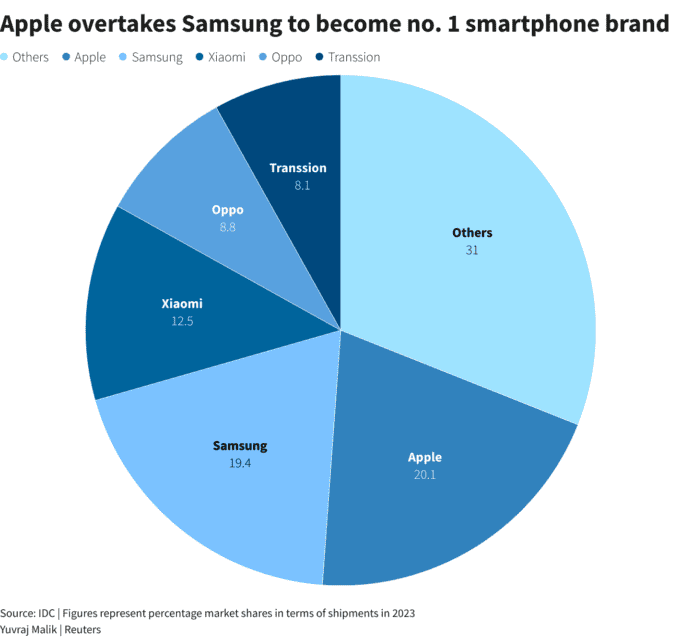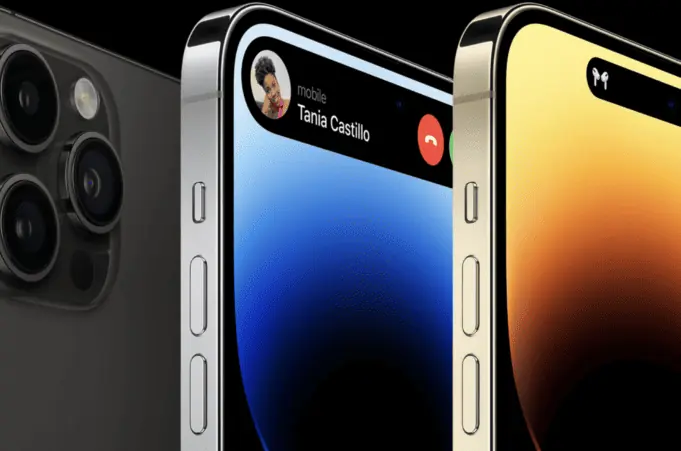According to IDC, Apple is back on top.
The iconic Apple iPhone has toppled Samsung, ending its 12-year run at the top.
Per the report from the research firm IDC (International Data Corp), Apple took 20% market share in 2023. Samsung didn’t trail by much (19.4%) so the lead could be fleeting. Essentially it appears to be a close two-horse race with small swings likely for years to come.
Trailing the leaders included several Chinese-based Android handsets made by the likes of Xiaomi (12.5%), Oppo (8.8%) and Transsion (8.1%).
Though Apple is now the top brand when it comes to phone sales, it’s not hard to see that the Android platform still dominates overall. Add together the top four Android brands and you get 48.% total share based on operating system. And that table cloth math doesn’t even include the brands included in the “Others” category (31%).

Clearly, despite the dominance of the iPhone, Android appears to be more broadly utilized by companies who are seeking an operating system they can build on without worrying about fees and royalties. Perhaps a shining beacon for the FOSS (Free and Open-Source Software) movement which in the last few years has gained momentum.
Next Up: Apple Vision Pro
All eyes in the coming months (and likely years!) will be on the Apple Vision Pro. CEO Tim Cook and team will, no doubt, continue to explore new market categories and seek to mine for more profit margin.
Mixed Reality and VR/AR or the trendier spin known as Spatial Computing could be one of those emerging consumer markets.
Though it’s hard to say. Meta (Facebook) has been at it for many years now with a variety of headsets (Meta Quest 2 and 3), and so far the products appear to appeal to a niche, rather than an expansive set of consumers.
Early reviews of Vision Pro cite the device as heavy and tiresome to wear for long periods — certainly a problem if the idea is to use it to replace a desktop or laptop or home theater. We typically spend hours at a desk working a computer or on a couch watching a movie. That some tech reviewers and influencers are struggling for just a short period is a bit concerning.
First time I tried Vision Pro: Damn this display is amazing and the eye tracking is like magic and this feels very future and also it’s a little heavy
Second time: immersion factor is still so high. Special videos are hit or miss, you gotta get the distance right. And wow this… https://t.co/iqSvs1e8LD
— Marques Brownlee (@MKBHD) January 16, 2024
Then there’s the (somewhat shocking!) price of the Vision Pro. At $3,500 USD this is, unlike the Meta Quest, clearly an experiment in premium, early adopter positioning. I expect Apple will greatly refine this product. By gen 2 or 3, we should get a lightweight, ready for the masses (or at least a larger niche) that might be priced, say, around $1,000-$1,500. Essentially, what you might pay for a top end iPhone model.
RELATED:
Foldable Apple iPhone in the future? Signs say yes
In any case, with smartphone sales struggling and slowing, Apple would do well to continue to mine for diversification. Vision Pro is clearly the go-to for 2024. You know they’re taking things seriously when you can go to an Apple Store for a personalized (prescription lenses) demo that is a whopping 25-minutes long. That’s commitment alright.
Apple Vision Pro pre-orders begin this week with shipments following in February.
RELATED:
Apple iPhone Discounts and Sales Now Available
Meantime, Apple and Samsung will duke it out for phone share. But if the trend of flat-lining handset growth continues then gaining or losing small share y-o-y really isn’t going to move the needle much. Hence, innovation and new product spaces could become key going forward.


